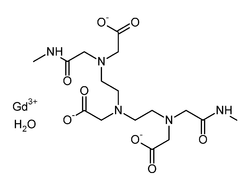Gadodiamide
 |
|
| Clinical data | |
|---|---|
| AHFS/Drugs.com | Micromedex Detailed Consumer Information |
| Pregnancy category |
|
| Routes of administration |
i.v. |
| ATC code | |
| Legal status | |
| Legal status |
|
| Pharmacokinetic data | |
| Protein binding | negligible |
| Metabolism | not metabolized |
| Biological half-life | 77.8 minutes |
| Excretion | renal |
| Identifiers | |
|
|
| Synonyms | 2-[bis[2-(carboxylatomethyl-(methylcarbamoylmethyl)amino)ethyl]amino]acetate; gadolinium(+3) cation |
| CAS Number | |
| PubChem CID | |
| DrugBank | |
| ChemSpider | |
| UNII | |
| KEGG | |
| ChEBI | |
| ChEMBL | |
| Chemical and physical data | |
| Formula | C16H28GdN5O9 |
| Molar mass | 591.672g/mol |
| 3D model (Jmol) | |
|
|
|
|
|
|
|
Gadodiamide is a gadolinium-based MRI contrast agent, used in MR imaging procedures to assist in the visualization of blood vessels. It is commonly marketed under the trade name Omniscan.
A 2015 study found trace amounts of Gadolinium deposited in the brain tissue of patients that had received Gadodiamide.
Gadodiamide is a contrast medium for cranial and spinal magnetic resonance imaging (MRI) and for general MRI of the body after intravenous administration. The product provides contrast enhancement and facilitates visualisation of abnormal structures or lesions in various parts of the body including the central nervous system (CNS). It does not cross an intact blood brain barrier but might give enhancement in pathological conditions.
In February 2008, Danish media stated that gadolinium-based agents may be associated with a toxic reaction known as nephrogenic systemic fibrosis (NSF) in some patients with severe kidney problems.
Some articles suggested that over 60 persons examined with Omniscan had either died or had been severely disabled as a result of the use of the product. However, a recent report by the Danish Medicines Agency stated that there were 35 cases of NSF reported after use of Omniscan and that 33 of these had been reported from a single centre in Copenhagen. However, already in 2001, a case of renal toxicity and pancreatitis associated with Omniscan use for arteriography had been reported. In their paper, the authors also referred to two other previous case reports (1998 and 1999) of acute renal failure after gadoteridol (Prohance) intraarterially and acute pancreatitis after intravenous gadolinium-diethylene triamine pentaacetic acid (Magnevist). A case of cardiac arrest has also been reported. Gadopentetate dimeglumine (Magnevist) was administered during an MR study of the head, and from the rapid onset of signs and symptoms and subsequent cardiovascular arrest, a cause-and-effect relationship was suggested. In the interest of public health, it seems important that not only renal disease should be considered a factor when decisions about the use of this kind of MRI contrast is taken.
...
Wikipedia
